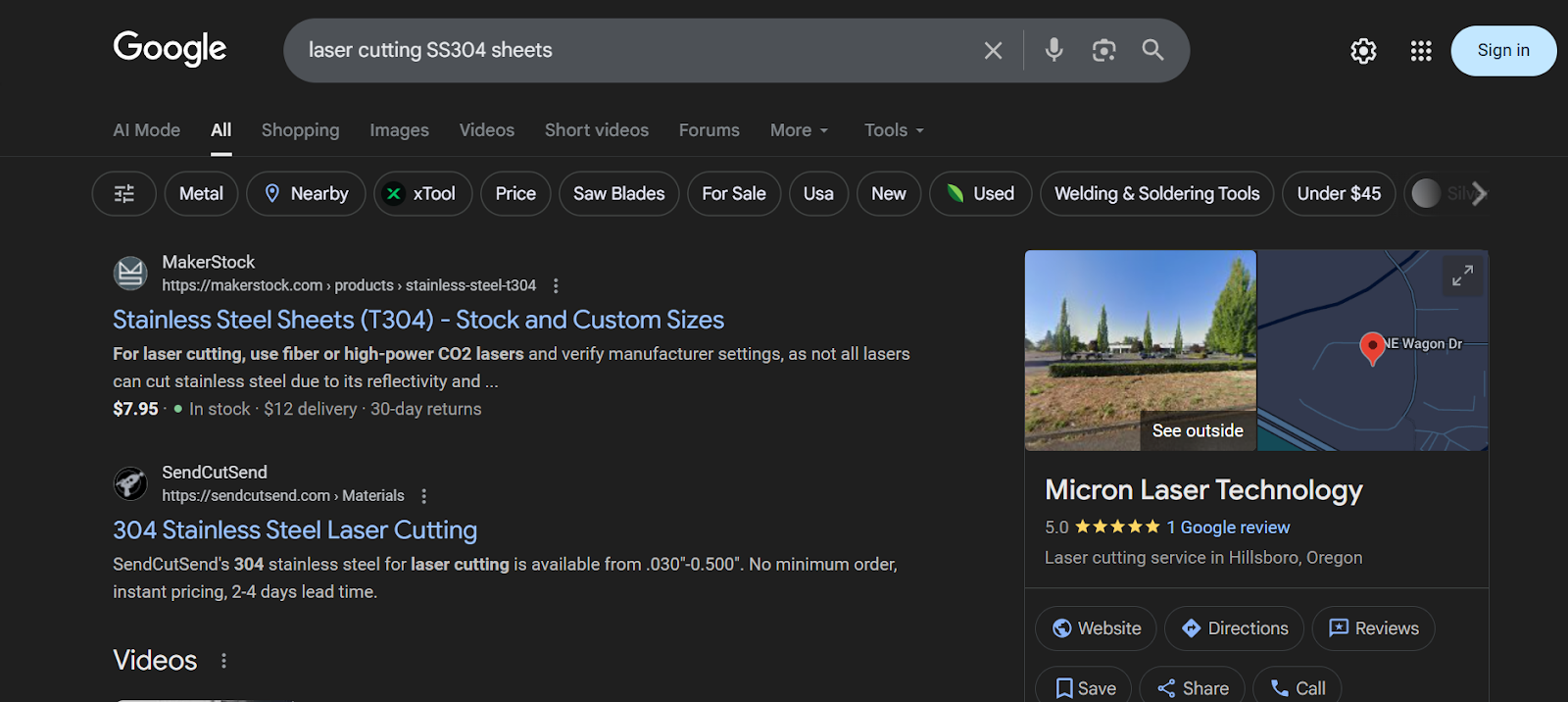Schedule a Call
Get started with your organic growth journey!




Most manufacturers in the US have heard of SEO, but very few have actually seen real revenue from it. And honestly, it’s not your fault if you failed. Traditional SEO often feels too technical, slow, or disconnected from how your buyers actually search.
Here’s the thing: around 49% of B2B marketers who have tried SEO strategically agree that it delivers better ROI than any other marketing channel. The problem isn’t SEO itself, it’s how it’s usually done.
In industrial markets, buyers aren’t searching for broad marketing phrases like “best-in-class manufacturing” or “comprehensive engineering support.” They search for the exact part numbers, materials, tolerances, and processes. If your website doesn’t match the way they search, you lose deals to competitors who simply show up first.
Industrial SEO becomes simple once you align your pages with real buyer intent. This guide shows you how
Industrial SEO is the practice of optimizing your website to appear on Google when buyers search for the products or services you offer. If someone types “laser cutting SS304 sheets”, SEO helps your website to show up right when the buyers need you.

Manufacturers today are using both traditional marketing, such as trade shows, referrals, and cold calls, along with digital marketing channels, such as SEO, paid (sponsored) ads, social media, email marketing, content marketing, and affiliate marketing.
Buyers compare vendors on Google, watch process videos on YouTube, download brochures, and request quotes directly from websites. Therefore, SEO stands out because it captures buyers at the exact moment they search for something specific.
SEO will work for you if:
If you are now ready to do SEO the right way, these are the core concepts you need to understand before anything else.

Optimize each page for buyers and Google.
On-page SEO means optimizing each page of your website for your buyers and search engines (like Google), so it shows up higher in search results (Search Engine Results Pages) and attracts the right buyers. This drives more business organically, meaning directly from Google (and other search engines like Yahoo, Bing, or Safari).
It includes using the right industrial keywords, writing strong titles and meta descriptions (brief info that appears below each title in the results page), structuring content with headings, improving internal linking (links leading to other relevant pages on your site), creating high-quality content, and ensuring the site loads quickly (under 3 seconds).
The research backs it up, too. The top 3 ranking factors of Google’s search results are high-quality content, page experience, and credible links.
Everything that happens BTS (behind the scenes) for your website.
Off-page SEO means building your company’s reputation and website authority through actions taken outside your site. This is mainly achieved by getting links from other trusted websites, earning mentions, and creating buzz on social media.
The process includes getting backlinks (votes of trust) from other authoritative sites, earning brand mentions, being discussed on social media, working with industry influencers, and building trust through reviews and directories.
The tech behind your website.
Technical SEO is about optimizing the technical aspects of your website so search engines (Google) can easily crawl (read your page), index (store in its database), and understand your content to show it to your readers.
This means ensuring your site loads quickly, is mobile-friendly, uses HTTPS, has a clear site structure and URL format, uses structured data, and avoids issues such as duplicate content or broken links. This improves your site’s search engine visibility and user experience.
The “near me” searches
Local SEO focuses on optimizing your online presence to attract customers from specific geographic areas.
It includes managing your business listings (Google My Business), ensuring consistent name, address, and phone information across directories, collecting local reviews, using region-specific keywords, and optimizing for maps and location-based searches. This helps local buyers find and trust your business more easily.
Read more: SEO for Manufacturers: A Complete Guide
Most manufacturers fail at SEO because they do things the wrong way. Your SEO strategy works only if it follows a simple, yet impactful sequence:

Most manufacturers jump into technicalities too early. But SEO only works if your core pages are clean, readable, and fast.
Think of this as checking a machine before hitting “start.”
What you need to fix first:
If the foundation is weak, Google won’t show you with your competitors, and even if it does, buyers won’t convert. This fixes both problems at once.
This is where most manufacturers go wrong: they target broad, marketing-style keywords like “award-winning services” or “premium quality deliverables” instead of technical, buyer-intent keywords that focus on your niche.
SEO for industries only works when you use the exact words your buyers use on Google.
Here’s how you can do it:
These bring buyers who are interested in purchases.
How to find the keywords?
If you choose the wrong keywords, you’ll get minimal traffic and no leads.
With the right ones, you’ll attract buyers who are already comparing suppliers.

If keywords tell you what buyers search, capability pages are where those buyers land. These pages are the real lead generators in industrial SEO, not just blogs.
Here’s what every capability/service page must include:
Simple page structure that works: Download this free customizable template
Most of the industrial traffic converts on these pages. Get them right, and SEO starts turning into real sales, not vanity traffic.
SEO for manufacturers or blogs isn’t meant for storytelling. Their job is simple: answer the exact technical questions buyers Google before choosing a supplier.
Here’s what industrial blogs should focus on:
Simple blog template/dynamic outline that works for manufacturing blogs:
Remember, blogs don’t replace your capability pages; they push more qualified buyers to them.

Think of technical SEO like machine maintenance — if the backend is slow, broken, or confusing, nothing else performs well. Google won’t rank you (show you on top), and buyers won’t stay.
Here are the technical fixes that matter most for manufacturers:
/services/cnc-machining/
/capabilities/laser-cutting/
Simple, clean, organized.
These might seem overwhelming or too difficult in reality. However,
There are simple tools you can use (even if you're not “techy”):
You can have the best content in the world, but if your site loads slowly, breaks, or confuses Google, you’ll never rank. Technical SEO removes this friction so your pages can actually show up and convert.
Off-page SEO is just a fancy way of saying: “Get other trusted websites to vouch for you.”
In the industrial world, it works exactly like vendor verification.
The more credible sources mention or link to you, the higher Google ranks you.
So, where do manufacturers earn high-quality backlinks:
Simple off-page activities your team can realistically do:
Google sees backlinks as proof of reliability, just as buyers check certifications or previous work before placing an order.

Many manufacturers often ignore local intent searches like “industrial supplier near me”, losing high-intent buyers who prefer nearby vendors.
Local searches convert faster — nearby buyers usually need quick turnaround, easier logistics, or proven reliability.
Here’s what to fix:
You show up for local “near me” searches, bringing in fast-moving, high-intent RFQs from buyers who want a supplier they can reach quickly. Look out for industrial SEO companies that can help you with these.
Suggested Read: 15+ Manufacturing SEO Companies
Most manufacturers “do SEO” but never check which pages actually attract leads— so they keep guessing instead of scaling what already works.
When you track performance, you see which keywords, pages, and tweaks bring real buyers… not just traffic.
Here’s what to keep in check:
Once you start tracking what’s driving real RFQs, you’re no longer “doing SEO.”
You’re running a 24/7 revenue engine.
The most important SEO metrics for industrial manufacturers to focus on include:
Most manufacturers don’t track SEO because analytics dashboards look confusing. But you just need five simple metrics to know whether your industrial SEO is working.
Choose what applies to you:
If your answer is 2 or more, your SEO is moving in the right direction.
With these simple tools, you can manage the basics, but do you know when to call in an SEO professional?
Most manufacturing teams can handle the basics of SEO until they hit one of these walls. If any of these sound familiar, it’s time to bring in an industrial SEO agency expert:
Once you know when you need an SEO industry expert, figure out who actually knows industrial SEO and who’s just selling generic marketing services.
Before you hire anyone, ask yourself (and them) these questions:
1. Do they understand industrial processes?
If they can’t explain in your buyer’s language: tolerances, materials, machining terms, or manufacturing workflows, they cannot create pages your buyers trust.
2. Can they create content that engineers respect?
Buyers want spec-driven pages, not fluffy marketing text. Ask for samples of technical blogs, product pages, and process guides.
3. Do they provide keyword research tied to specs?
They should deliver keyword lists based on your industrial niche. This includes the specifics of your services, like product specs, capabilities, industries, and applications.
4. How fast can they produce pages?
Industrial companies can’t wait 3–6 months for content. Ask how long it takes them to research, write, review, and publish a technical page. There are AI-powered companies that can generate 6 months of industrial content in 4-5 weeks.
5. What KPIs will they track for you?
Look for real metrics tied to revenue:
If they talk only about “likes,” “impressions,” or “brand awareness,” that’s not industrial SEO. They should speak of “clicks”, “conversions”, “leads”, “sales”, “week-on-week growth”, and “revenue”.
Remember,
When you align your pages with how real buyers search, results stack month over month. Industrial niches actually have less competition, which means even a small factory can outrank bigger players with consistent, technical content.
Start simple, stay focused, and SEO becomes one of your most reliable lead engines.
Gushwork helps industrial manufacturers get more website traffic and sales by creating content that attracts the right buyers, fast and hassle-free. Talk to an expert today!
Yes. Even niche manufacturers can gain from SEO by targeting long-tail, technical keywords (e.g., “CNC machining 6061 aluminum”) that real buyers use. These specific searches often mean low competition and high intent, driving qualified leads rather than broad, generic traffic.
Focus on the language your buyers use. Choose tools (or simpler methods) like Google Autocomplete, “People Also Ask,” and competitor sites — and combine that with your sales team’s vocabulary.
Absolutely. Technical SEO — like site speed, mobile usability, HTTPS, and clean URL structure— ensures Google can crawl (read your content) and index (store in the database) your site and helps buyers find and trust your detailed technical content.
Because B2B manufacturing sales cycles are complex: many decision-makers, offline conversions, and long purchase cycles. Without setting up proper tracking and measurement (e.g., form conversion tracking, analytics dashboards), it’s hard to connect SEO activity to real business results.
SEO is not instant. Many industrial sites see steady improvements in 3–6 months, especially for niche, technical keywords — but full ROI often compounds over time as content, authority, and site structure mature.
.svg)